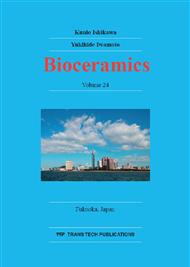[1]
J. Lupovici, Regenerative Strategies for Anterior Esthethic Reabilitation, Compendium 31(8) (2010) 614-623.
Google Scholar
[2]
F. Khoury, H. Antoun, P. Missika, Bone Augmentation in Oral Implantology, Quintessence, (2007) 16 -387.
Google Scholar
[3]
R. Kuhls, M. Werner-Rustner, I. Kuchler, Human demineralized bone matrix as a bone substitute for reconstruction of cystic defects of the lower jaw, Cell and Tissue Banking, 2, (2001), 143-153.
DOI: 10.1023/a:1020173119669
Google Scholar
[4]
R.E. Marx, Carg A. K., Dental and Craniofacial Applications of Platelet-Rich Plasma, Quintessence (2005) 53 -64.
Google Scholar
[5]
J.L. Rutkowski, J.M. Thomas, L. Bering, An Analysis of a Rapid, Simple and Inexpensive Technique Used to Obtain Platelet-Rich Plasm for Use in Clinical Practice, Journal of Oral Implantology, Vol XXXIV/1(2008) 25 -33.
DOI: 10.1563/1548-1336(2008)34[25:aaoars]2.0.co;2
Google Scholar
[6]
E.A. Anitua, I.O. Andia, P. Nurden, A New Aproach to Bone Regeneration Plasma Rich In Growth Factors, Puesta Al Dia Publicaciones( 2001) 81-145.
Google Scholar
[7]
E.A. Anitua, A Biological Approach to Implantology, Team Work Media Espana (2009)41–107.
Google Scholar
[8]
E.A. Anitua, G. Orive, I. Andia, Use of PRGF to accelerate bone and soft tissue regeneration in postextraction sites, Dental Dial. 1 ( 2006) 3-14.
Google Scholar
[9]
E. A. Anitua, The use of plasma-rich în growth factors (PRGF) in oral and maxillofacial surgery and periodontics, Journal of the General Council of Spanish Dental Associations, Vol. 6, No. 3 (2001)305 - 315.
Google Scholar
[10]
D. Busser, 20 years of Guided Bone Regeneration, Quintessence (2009) 82- 204.
Google Scholar
[11]
K.U. Gomez, J.L. Carlini, C. Biron, Use of Allogeneic Bone Graft in Maxillary Reconstruction for Installation of Dental Implants, J. Oral Maxillofac. Surg., 66 (2008) 2235-2338.
DOI: 10.1016/j.joms.2008.06.006
Google Scholar
[12]
M. Perriat, C. Chavrier, Implant bone reconstruction using allogenic bone grafts, Implant 6(3)( 2000) 187-197.
Google Scholar
[13]
W. de Vos, J. Casselman, G.R.J. Swennen, Cone-beam computerized tomography (CBCT)imaging of the oral and maxillofacial region: A systematic review of the literature, Int. J. Oral Maxilofac. Surg., 38 (2009) 609-625.
DOI: 10.1016/j.ijom.2009.02.028
Google Scholar
[14]
G.R.J. Swennen, Schutyser F., Three-dimensional cephalometry: spiral multi-slice vs cone-beam computed tomography, Am J. Orthod. Dentofacial Orthop., 130( 2006) 410-416.
DOI: 10.1016/j.ajodo.2005.11.035
Google Scholar
[15]
Benavidez E., Rios H.F., Ganz S.D., Use of cone beam computed tomography in implant dentistry: the International Congress of Oral Implantologists consensus report, Implant Dent. (2012)21/2, 78-86.
DOI: 10.1097/id.0b013e31824885b5
Google Scholar
[16]
G. Watzek, Implants in Qualitevely Compromised Bone, Quintessence (2004) 59.
Google Scholar


